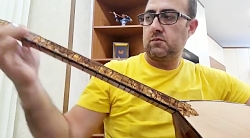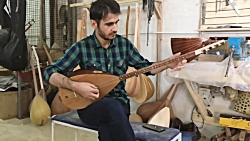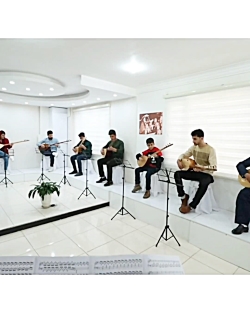Online Baglama Course
More Links
- Accordion
- Cajon
- Cello
- Clarinet
- Classic Violin
- Double Bass
- Electric Guitar
- Flute
- Guitar
- Handpan
- Hangderam
- Harmonica
- Harmonica
- Harp
- Lakota Fluet
- Melodica
- Persian Tang
- Piano
- Saxophone
- Violin Alto


Adnan Ahmadi - Baglama
Tuition : 750,000 toman
Yashar Behnoud - Baglama
Tuition : call for price
Ardel Arzanjan - Baglama
Tuition : 0 tomanStudents Videos
Baglama
A brief introduction with baglama instrument
Baglama is considered one of the traditional and popular stringed instruments in traditional Turkish and Kurdish music. This instrument, with its wooden frame in the shape of a mushroom with two or three strings, touches the listeners' ears perfectly. The players of this instrument plays it with a plectrum that you have to use two main fingers and one auxiliary finger to play it. Baglama is often used together with other instruments of Turkish folk music, such as the circle and the fiddle (kamancheh), and is considered one of the main and very important instruments in the traditional music structure of this country.
Baglama category includes stringed instruments and long-necked ouds (barbitons) that are used in all kinds of music; such as Ottoman classical music, Turkish folk music, Turkish Arabic music, Azerbaijani music, Bosnian music, Kurdish music and Armenian music.
The difference between divan and baglama
Baglama and divan are the kinds of instruments used in different cultures, especially in Turkey and some parts of Iran and Iraq (Kurdistan). However, there are important differences between these two:
- Size: Divan is generally bigger than baglama.
- Bowl: Divan's bowl is deeper than baglama.
- Number of frets: Divan has more frets than baglama.
- Tuning: The tune of Divan is lower than baglama.
- Voice: Divan's voice is more expressive and deeper than baglama's.
- Being played in different regions of the world such as Europe, Asia, the Black Sea, the Caucasus and the countries such as Syria, Iraq, Iran and Bosnia and Herzegovina.
- Deeper bowel at back and very long neck
- The ability to play with a plectrum or with a fingering called Shalpe
- The most common stringed instrument in Turkey with seven strings that are divided into two, two and three strings
- The ability to tune in different ways and with different names according to the region and size: Baglama, Divansazi, Bozok, Choghur, Kopoz Irizva, Kora and Tambora.
- Kora is the smallest member of the baglama family and tambora is the larger member which is tuned on an octave lower.
- Three main parts: The bowl (takneh) is made of mulberry or juniper wood, beech, poplar or walnut. The voice plate (gouges) is made of poplar and the handle (shireh) is made of beech or juniper.
Baglama originated in Central Asia and spread to Anatolia and other parts of the Middle East and the Balkans by Turkish immigrants. Skilled musicians can play baglama without a plectrum only with their fingers.
Kurdish baglama
The baglama used in Kurdish music is very similar to its doppelganger (Turkish divan) which is used in Turkish music; Although there may be minor differences in tuning or playing styles; So although baglama is not exclusively Kurdish, it is a very important instrument in Kurdish music.
Online baglama training
Online baglama training provides a suitable and accessible way for interested musicians to drowned themselves in the intricacies of this instrument, regardless of geographical limits. By baglama online classes and baglama video tutorials, experienced teachers can guide students through the path of learning baglama step by step, from knowing basic techniques to advanced musical concepts.
One of the key benefits of baglama online learning is its flexibility. Students can fix their studying schedule according to their own pace and availability and this will eliminate the necessity of forced schedules or travel arrangements. Whether these people are the beginners who are looking to understand the basics or the experienced ones who want to refine their skills, baglama's online training can help them achieve their various educational goals and improve their skill levels.
In addition to, baglama's online training goes beyond the borders and connects students with passionate teachers and other students all around the world. This multicultural exchange strengthens a high-energized community of musicians united by a common love to a musical instrument. They also make the learning experience more powerful by being exposed to different musical styles, techniques and traditions.
Learning baglama at home
Learning baglama at home brings a set of advantages, one of the most important of them is flexibility. With online resources, educational videos, and virtual tutorials which are simply available, interested musicians can arrange their learning experience to individual schedules and preferences. Besides, learning baglama at home eliminates geographical limits and commuting boundaries, making Turkish music accessible for the interested ones all around the world. Regardless of whether you live in a busy side of the big cities or even in remote countryside, the magic of baglama can be ready to play by your side.
One of the other key benefits of learning baglama at home is the ability to make a personalized learning environment. Choosing the ideal training space and arranging the repertoire that is made according to your musical tastes, along with the patience and guidance of experienced teachers, will help you speed up your improvement; In this case, you can learn the basic techniques completely and move on to more complex melodies and rhythms. In addition to, learning baglama at home creates a sense of independence and self-discipline. Online learning creates a different world. And because of this purpose, you should find a qualified and suitable teacher, get on with flexibility and at last get ready to learn baglama.

Buying baglama
When you’re buying a baglama, you must consider this fact that is so important to check out the different available options so you can evaluate your preferences for the sound, the ability to play, and the skills. It should be mentioned that baglama instrument is available in different designs and colors which are suitable for every kind of tastes. The price of this instrument can be different according to many factors such as; material quality, industry and brand reputation.
Basic-level baglama designed for the beginner or ordinary players may be available at more affordable prices. These instruments are perfect for learning the basics and experimenting with different playing styles, making it an ideal choice for those who aren’t familiar to this instrument. On the other hand, expensive baglamas made with premium materials according to them being detailed may have higher prices. These instruments are valuable for their superior sound quality, the ability of playing and durability. So these make them more being-preferred choice for professional musicians and the interested ones who are looking for the ultimate musical experience.
Besides, buying baglama from reputable sellers, such as music stores who are experts in Turkish instruments, can help you ensure about originality and quality. It is also recommended to read comments, get recommendations from other musicians, and if it’s possible, try different baglamas before making a final decision to find the best one which is suitable for you.
Final words
It is obvious that this Turkish stringed instrument has a significant place in contemporary music education and performance. Baglama's online learning provides a world of opportunities for interested musicians, offering convenient and simple access to learning resources and specific guidance regardless of geographic location. Through online virtual platforms and digital tutorials, students can develop their skills at a specific pace, from learning basic techniques completely to strengthening advanced playing styles.






